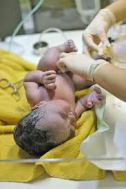EBP Preventive Action: Evidence-based, distinct infant naming can avoid sentinel events related to misidentification of newborns (TJC, 2015).
Problem: Misidentification errors of NICU babies are common  (Gray et al., 2006). About 12% of the 4 million born in U.S. hospitals were admitted to NICU’s. At birth every infant requires quick application of an armband, and when parents have not yet decided on a name the assigned name is often quite nondistinct (e.g., BabySmith).
(Gray et al., 2006). About 12% of the 4 million born in U.S. hospitals were admitted to NICU’s. At birth every infant requires quick application of an armband, and when parents have not yet decided on a name the assigned name is often quite nondistinct (e.g., BabySmith).
Evidence: A pretest/posttest of a new, more infant-specific naming system was “conducted in order to examine the effect of a distinct naming convention that incorporates the mother’s first name into the newborn’s first name (e.g., Wendysgirl) on the incidence of wrong-patient errors. We used the Retract-and-Reorder (RAR) tool, an established, automated tool for detecting the outcome of wrong-patient electronic orders. The RAR tool identifies orders placed on a patient that are retracted within 10 minutes and then placed by the same clinician on a different patient within the next 10 minutes” (Adelman et al., 2013).  Their results? RAR events were reduced by 36.3%. Their recommendations? Switch to a distinct naming system.
Their results? RAR events were reduced by 36.3%. Their recommendations? Switch to a distinct naming system.
Using something like Judysgirl Smith is infant specific. “In the case of multiple births, the hospital adds a number in front of the mother’s first name (ex: 1Judysgirl and 2Judysgirl)” (TJC).
TJC recommends:
- “Stop using Babyboy or Babygirl as part of the temporary name.
- Change to a more distinct naming convention.
- Train staff on the distinct naming convention.
- Follow the recommendation in National Patient Safety Goal 01.01.01 and implement use of two patient identifiers at all times.
- As soon as parents decide on their baby’s name, enter that name into the medical record instead of the temporary name.”
Commentary: While this is just one study, RNs should evaluate whether it is riskier to continue any current practice of non-distinct naming or to switch practices to distinct naming. No risks were identified to the distinct naming system & it likely requires only the resource investment of educating staff. Adelman et al.’s (2013) study is current, moderately strong, quasi-experimental evidence that showed a significant decrease in errors that could have sentinel event outcomes. Any who make the switch should monitor outcomes. All who don’t make the switch should, too!
Critical Thinking: Examine the risks, resources, & readiness of staff in your facility to make the switch to a distinct NICU infant naming system?  Should the naming system be extended to all infants?
Should the naming system be extended to all infants?
Want more information? See
- Adelman et al. (2013). Use of Temporary Names for Newborns and Associated Risks. Pediatrics, 136(2):327-33. doi: 10.1542/peds.2015-0007. Epub 2015 Jul 13. Retrieved from http://pediatrics.aappublications.org/content/136/2/327.long
- Gray JE, et al. (2006). Patient Misidentification in the Neonatal Intensive Care Unit: Quantification of Risk. Pediatrics, 117(1). Retrieved from http://pediatrics.aappublications.org/content/117/1/e43.long
- The Joint Commission (2015 October). Temporary names put newborns at risk. Quick Safety- Issue 17. Retrieved from TJC Quick Safety – Issue 17 with references see http://www.jointcommission.org/issues/article.aspx?Article=B7m8UUbXo1zc9Kx%2fsYHIKtc5JxWzumvlTZZmsphVx1w%3d

In support of distinct naming system, looks like it will be easy to adopt and nurses should be willing to adopt it as EBP to avoid misidentification.
So happy I can access the EBP blog now.
LikeLike
I am surprised that such a simple change could reduce the errors so greatly. Policy changes and education were the only additional work that was needed.
Laurie Walter
LikeLike